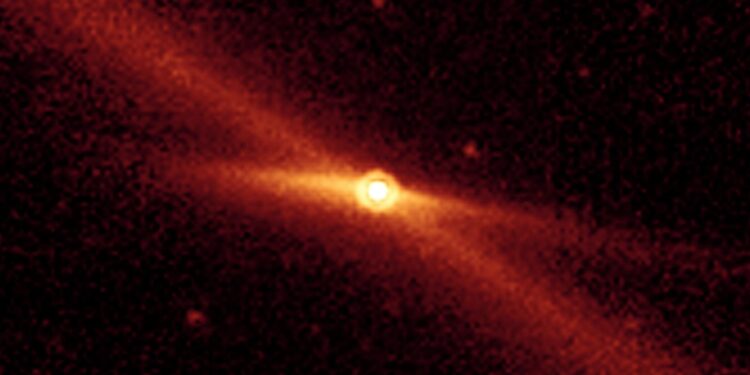This image taken by NASA’s Spitzer Space Telescope shows Comet Encke riding its trail of pebbly debris. Every October, Earth passes through Encke’s wake, resulting in the famous Taurid meteor shower. Credit: NASA/JPL-Caltech/Univ. of Minn.
Astronomers have some good news about potentially dangerous asteroids lurking near our planet: There aren’t as many as we thought.
Using the Zwicky Transient Facility (ZTF) telescope to survey large swaths of sky, a team of researchers led by the University of Maryland studied a stream of space debris known to drift near Earth, called a Taurid swarm.
The Taurids, thought to be the remains of a large comet called Encke, can be seen from Earth as highly visible meteor showers in October and November. This region has long intrigued astronomers because of its potential to host hidden and dangerous asteroids, but researchers have been unable to confirm or refute the existence of such dangers – until now.
The group’s findings were announced at the annual meeting of the Division of Planetary Sciences of the American Astronomical Society on October 7, 2024.
“We took advantage of a rare opportunity when this asteroid swarm came closer to Earth, allowing us to more effectively search for objects that could pose a threat to our planet,” said Quanzhi Ye, who oversaw the project and is an assistant researcher. in the UMD Department of Astronomy. “Our results suggest that the risk of being hit by a large asteroid from the Taurid swarm is much lower than we thought, which is excellent news for planetary defense.”
Prior to this study, researchers had hypothesized that the Taurid swarm contained a considerable number of large kilometer-class space rocks left behind by a large object up to 100 kilometers (62 miles) wide. Large objects can cause regional damage if they hit Earth, such as the Chelyabinsk asteroid which struck Russia and injured more than 1,600 people in 2013. Even larger objects can cause events of up to extinction, like the asteroid that killed the dinosaurs more than 66 years ago. millions of years ago.
“Fortunately, we found that it is likely that there are only a handful of asteroids – perhaps only nine to 14 of them – that fit this large class in the swarm ” Ye explained. “Judging from our findings, the parent object that initially created the swarm was likely closer to 10 kilometers in diameter rather than a massive 100 kilometer object. Although we should always be vigilant about impacts from asteroids, we can probably sleep better knowing these results.
According to Ye, the Taurid swarm holds important clues to planetary evolution, particularly because of its connection with Comet Encke. Encke, which has one of the shortest orbital periods (the time it takes to complete one rotation around the sun) of known comets at just 3.3 years, is also unusually large and dusty for a short-period (orbiting around the sun in 200 years). or less). Given all available evidence, scientists believe that Encke has experienced significant fragmentation in the past and may continue to collapse in similar ways in the future.
“Studying the Taurid swarm helps us understand how small celestial bodies like comets and asteroids form and break up over time,” Ye said. “Our research has implications not only for asteroid detection and planetary defense, but also for our broader understanding of solar system objects.”
While the study results are reassuring, the team believes they also highlight the need for continued vigilance and improvements in detection capabilities. Using advanced facilities such as the ZTF telescope, capable of efficiently conducting large surveys of the sky and tracking potentially dangerous near-Earth objects, the researchers plan to conduct follow-up observations in the coming years, when the swarm of Tauride asteroids will pass near Earth again.
“We have opportunities in 2025 and 2026 to further refine our results,” Ye said. “As a result, we are excited to continue this important work.”
Provided by University of Maryland
Quote: New study eases concerns about possible ‘apocalyptic’ asteroid swarm (October 7, 2024) retrieved October 7, 2024 from
This document is subject to copyright. Except for fair use for private study or research purposes, no part may be reproduced without written permission. The content is provided for informational purposes only.



